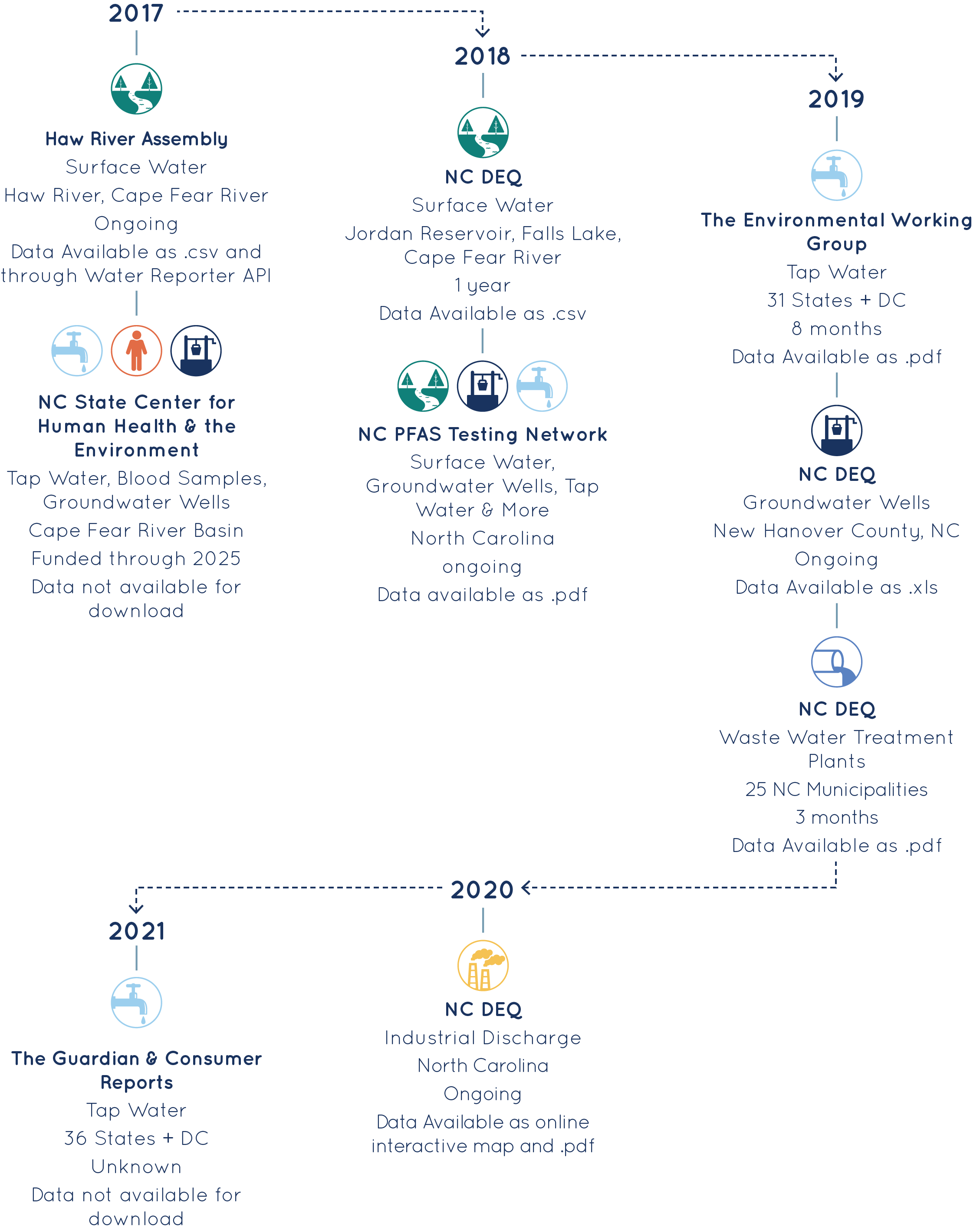PFAS Monitoring in North Carolina
How Better Data Management is Key to Better Policy Decisions

Transforming raw data into tangible conclusions relies on efficiency and accuracy. It is impossible to achieve this without clean, standardized datasets. When researchers have to find and integrate many different disorganized and unstandardized datasets it diminishes their ability to draw vital conclusions about risks and priorities. This time-consuming and difficult process also means that policymakers often do not have access to the information they need to make timely and informed decisions.
“When researchers have to find and integrate many different disorganized and unstandardized datasets it diminishes their ability to draw vital conclusions about risks and priorities.”
Background
PFAS (per- and poly-fluoroalkyl substances) are a group of over 5,000 different types, or analytes, of man-made chemicals for industrial and commercial use. PFAS are often found in firefighter foam, kitchen utensils, cleaning supplies, herbicides, textiles, and other common products due to their indestructible, non-stick, and waterproof properties. These characteristics are caused by strong carbon bonds. PFAS get their strong carbon bonds from their hydrophilic (water-loving) heads and hydrophobic (water-repellent) and lipophobic (fat-rejecting) tails. “Long-chain PFAS” refers to analytes with more than eight carbon chains (“C8”) such as PFOA and PFOS, and these take much longer to degrade than “short-chain PFAS” (e.g., PFBA, PFBS). The long-chain analytes have been given the nickname “forever chemicals” because they take an extremely long time to break down and dissipate on their own. Given the ubiquity and near permanence of these chemicals, it is likely that almost everyone has some level of PFAS in their blood.
PFAS Regulatory Landscape
Still considered an “emerging contaminant,” the EPA’s attention began narrowing on PFAS after Robert Bilott, a corporate defense lawyer, discovered that DuPont, one of the world’s largest chemical companies, had long studied PFOA’s health effects and had linked it to cancer and birth defects without making the findings public. In a 2004 settlement, DuPont agreed to pay millions of dollars in civil penalties and Supplemental Environmental Projects to help protect the public against contamination.
Since that settlement, further lawsuits and public attention have driven the EPA to establish a non-enforceable health advisory limit of 70 parts per trillion for combined PFOA and PFOS in drinking water. The EPA is currently working on transitioning this health advisory limit into a formal regulation.1 In the absence of more stringent federal PFAS standards, some states have passed their own enforceable and advisory limits for certain analytes. Currently, North Carolina has an unenforceable health guideline for only one type of PFAS – HFPO-DA, known as GenX.
In October of 2021, the EPA announced a new Strategic Roadmap to address PFAS contamination nationwide. The roadmap seeks to set new enforceable drinking water limits, a hazardous substances designation, a toxicity assessment for GenX, and increase PFAS monitoring, data collection, and research, among other actions.2

Problems in North Carolina
For decades, two chemical companies, 3M and DuPont (later Chemours), have manufactured products with various PFAS – notably PFOA and PFOS – to create their signature Scotchgard™ and Teflon™ products. In 2008, DuPont’s facility in Fayetteville, North Carolina began manufacturing PFOA, PFOS, adding GenX when the facility became Chemours. Numerous other industrial, military, and airport sources of PFAS also contribute to contamination in North Carolina.
In July 2018, Cape Fear River Watch, an environmental protection organization, sued the North Carolina Department of Environmental Quality (NCDEQ) to force Chemours to stop depositing wastewater in the Cape Fear River which posed a significant risk to Fayetteville and downstream residents. In August 2019, Cape Fear River Watch, represented by the Southern Environmental Law Center, filed a federal lawsuit against Chemours for violating the Clean Water Act and Toxic Substances Control Act. The suit was later dropped as part of a settlement which resulted in a consent order that required Chemours to cease its discharges and add scrubbers to its smokestacks to prevent airborne PFAS pollution.
Political Kickstart
In response to these and other water quality concerns, in 2018 the North Carolina General Assembly directed the North Carolina Policy Collaboratory to study the occurrence, distribution, and remediation of PFAS in water across the state. In a collaboration between Governor Cooper’s administration, Triangle researchers, and local NGOs, the General Assembly allocated $5 million to fund 20 Triangle university researchers to conduct baseline PFAS water quality testing. The group of researchers was named North Carolina’s PFAS Testing Network (“Network”). The original intent was to create an integrated framework to transition emerging contaminant testing and analysis capacity from academic institutions to NCDEQ.
PFAS Sample Collection and Monitoring Efforts
North Carolina Department of Environmental Quality
In 2018, the Division of Water Resources within NCDEQ performed three studies to characterize the presence and concentration of PFAS, as part of a broader emerging compounds mitigation effort. These studies collected water samples from three major public water system (PWS) basins: Jordan Reservoir and its immediate watershed, Falls Lake and its immediate watershed, and various public water supply reservoirs in the Cape Fear, New, and Watauga River Basins. This dataset is publicly available as a downloadable .csv file. All analysis was conducted at the EPA Athens lab location. The results are available in PDF format as public memos.
Note that PFAS levels in PWS basins are not necessarily the same as what comes out of connected home taps – different intake locations, treatment methods, and other factors influence end-point contaminant presence. Without extensive at-the-tap testing, inferences about household risk based on these results are still inconclusive. In the absence of at-the-tap testing, however, these results are one of the best methods we have to help to identify possible risks.
Responding to continued litigation and public pressure surrounding the Chemours/DuPont pollution and subsequent discovery of elevated levels in surrounding water, NCDEQ also ordered 25 municipalities to test for specific PFAS at their wastewater treatment plants for three months beginning in July 2019. This data is available as a static PDF report rather than a malleable or downloadable dataset.
Another NCDEQ effort is underway to develop an overall management strategy to reduce the levels of PFAS compounds in the Cape Fear River Basin. As part of this effort, NCDEQ is asking industrial dischargers to monitor for releases of PFAS and 1,4 dioxane. Monitoring requirements went out to at least 19 industries, with results due by June of 2020. The results were consolidated into an interactive data results map and are downloadable as tables in PDF format.
NCDEQ is also investigating groundwater wells located in New Hanover County and has completed three rounds of sampling. The results can be seen via a map or downloaded as an excel spreadsheet. The 2019 results were shared with the Cape Fear Public Utility Authority who also disclosed detections of PFAS in wells in their system.
North Carolina PFAS Testing Network
Starting in July of 2018, the PFAS Testing Network, a collaboration of 100+ members from six UNC system universities and Duke University, with funding from the North Carolina General Assembly via the NC Policy Collaboratory, was charged with informing: 1) state regulators and policymakers about sources and levels of PFAS, with a focus on public water supplies; 2) environmental strategies for reducing or eliminating PFAS exposures; and 3) public understanding of the toxic effects of PFAS in humans. Several subject-specific teams were created including, Project Management, Water Sampling & Analysis, Private Well Risk Modeling, PFAS Removal Testing, Air Emissions & Atmospheric Deposition, Applied Research Opportunities, Communications, and Data Science & Management.
The research teams generated large amounts of heterogeneous data relating to sample collection and analysis of PFAS concentrations in more than a dozen different types of environmental and biological specimens. Their final report, with scientific and policy recommendations, can be viewed online.
The Network included a team evaluating PFAS removal performance by common filters, which analyzed water quality tests from home faucets. However, the way the sample collection was conducted did not enable researchers to determine a pattern of household risk in the state.

Jamie DeWitt’s lab in the Department of Pharmacology and Toxicology at the Brody School of Medicine has also continued research on the toxicity of PFAS. Her lab is focused on immunotoxicity and recently published work indicating that PFAS have toxicological potential, but require further study.
Due to the academic nature of the Network’s mission, the data must first be published in reports before the public can access it and is yet to be made available for public download. Furthermore, there are privacy concerns with much of the data that may prevent it from ever being completely accessible.
Non-governmental Organizations
Along with state agencies and academic research teams, many nonprofit organizations have gotten involved with PFAS data collection efforts. In 2017, the Haw River Assembly was awarded one of the NC State Center for Human Health and the Environment’s Community Grants to assess levels of PFAS in the Upper Cape Fear and Haw Rivers. Data collected with grant funding was used to inform the public, make recommendations to local and state agencies to address contamination, and collaborate with statewide advocacy groups to promote protective legislation. The Haw River Assembly also worked with legal advisors at Southern Environmental Law Center to inform policy and educate state agencies on what tools are available to immediately address discharges of toxic PFAS compounds.
With support from the Pisces Foundation, the Haw River Assembly’s River Keeper partnered with the Internet of Water and the Commons in 2020 to modernize their data management system. Using Water Reporter, this project integrates data from the Haw River Assembly’s many monitoring programs (including PFAS monitoring) into one easily accessible online platform. Users can visualize the data on an interactive map or download them as .csv files or through Water Reporter’s API.
Other NGOs have conducted broader, multi-state PFAS testing. The Washington D.C. based Environmental Working Group recently tested tap water at 44 locations in 31 states and the District of Columbia. The highest PFAS level detected in the national study was 186 parts per trillion at an elementary school in Brunswick County on the North Carolina coast – which pulls its drinking water from the Cape Fear River. The Environmental Working Group’s samples, collected by staff or volunteers between May and December 2019, were analyzed by an accredited independent laboratory for 30 different PFAS chemicals. Another collaborative project between the Guardian and Consumer Reports tested 120 tap water samples from locations across the US.
So many different sampling efforts across a variety of organizations have inevitably led to fragmented datasets, with different standards, published in different formats. This fragmentation has made it difficult to consolidate the data into information and clearly communicate the results.
“Is my drinking water safe?”
To answer the most basic questions about the safety of drinking water, emerging PFAS contaminant analyses try to identify the factors affecting the occurrence and distribution of chemicals, public and ecological exposure, and appropriate remediation options. Addressing these questions requires access to and integration of lots of related data, such as hydrologic trends, temperature, locations of potential sources, groundwater well sites, households connected to the public water system, in addition to multiple years of PFAS samples to establish temporal trends. Ultimately, this analysis determines the degree of public health and ecological risk and informs mitigation options. The PFAS Testing Network has a set of FAQs that also seek to answer this question for anyone curious or concerned about PFAS contamination in North Carolina’s drinking water.
In addition to health concerns, the information revealed by these research projects has financial impacts on local communities. Greensboro had planned to spend $31 million on a system to filter out PFAS, but those plans are now on hold as the city awaits regulations from the state and federal governments. The town of Pittsboro is also considering a multimillion-dollar filtration system.

PFAS Dataset Integration
Testing for PFAS is most useful when researchers and policymakers can build an accurate big-picture view of contaminant presence and its implications for potential sources and exposure risk. The limited capacity for monitoring resulting from the lack of regulation underscores the importance of coordination between the academic and policy communities, such as NCDEQ and the PFAS Testing Network. Decisions for mitigating emerging contaminants will always be based on limited available knowledge, but these uncertainties can be minimized if the data collected by regulatory agencies, academics, NGOs, and environmental organizations are standardized, accessible, and interoperable.
Tracking down various reports from every relevant collection agency or reporting quarter is time-consuming and could cause researchers to overlook important datasets. It is difficult to see the big picture of state-wide contamination when the datasets are dispersed across various organization platforms or buried in site-specific or executive order reports.
The decentralized nature of all of the various PFAS sampling efforts in North Carolina also makes it difficult to integrate data from various sources because the data are unstandardized and often incompatible. For example, inconsistent analyte names (e.g., “PFUnA/PFUdA” versus “PFUnA”), not testing for the same compounds, the lack of a standard way to represent reporting limits, and inconstancies in the reporting of other technical information make data integration inefficient and can sometimes make it impossible to accurately compare or integrate different datasets. Complete and standardized metadata is essential to enable researchers to combine data and conduct integrated analysis.
Inconsistent, inaccessible formats for data can also limit their usefulness. If data is only accessible as a static PDF, it is prohibitively time-consuming to manually move these values into a dataset. Completing such tasks is an inefficient use of resources and introduces the potential for error during copying, thereby impacting the validity of final analyses. The accessibility of data is key to enabling and encouraging non-agency staff to analyze emerging contaminants and reduce duplicative efforts.
Data collected under different auspices at different times can often be of variable quality as well. “Dirty” datasets – those that contain incorrect or inconsistent data – can generate misleading results. Therefore, one of the first steps to any collation and integration of many datasets includes “cleaning” them to find and correct inaccurate or inconsistent data without deleting what is necessary for valid insights. When done properly, cleaning eliminates many errors, improves data integrity and analysis, and ensures that decision-makers have access to high-quality information.
The PFAS testing network utilized a data communication and management team to provide more centralized and standardized data which proved useful when comparing doses, exposure periods, sampling procedures, and health risks. The Network surveyed relevant database models for storing the highly heterogeneous Network data and associated metadata. They selected Observations Data Model2 (ODM2) because it provided the requisite level of detail and flexibility for the various data types. They adapted this model with specialized vocabularies relevant to the PFAST Network to facilitate data integration across research teams. They also consulted research teams to determine a common PFAS naming convention while allowing for some flexibility and variation to accommodate individual team’s needs
The PFAS testing network has plans to widely share data via their Data Hub – unfortunately, the pandemic interrupted the release, and it has yet to be activated. The Data Hub will provide a map interface with graphical elements in addition to the various data search options (by compounds, datasets, or sampling location). Users will be able to quickly see where research teams have conducted specific kinds of sampling. The list of available datasets will be displayed beneath the map for the locations shown. The Data Hub will greatly improve public access and communication of PFAS data but is not integrated with state or wastewater monitoring efforts.
PFAS Communication
Data management decisions should consider the intended audience. Deciding who the data is meant for – agency-use, researchers, legislative officials, or the general public – is the first step to determining the most appropriate platform and format because each group has their own needs for reading, analyzing – and ultimately using – the datasets. For example, reporting PFAS levels in a publicly accessible PDF memo might suffice for notification purposes but fails to support inter-agency or academic research applications.
Contaminant data is often presented in reports and datasets that require subject matter expertise to interpret. These reports can stump even experienced water quality professionals in their communication of units and reporting limits, and to an unpracticed observer, they can look like a foreign jumble of characters obscuring meaningful conclusions. For example, in PFAS monitoring data nanograms per liter (ng/L) are used interchangeably with parts per trillion (ppt) because they are equivalent. However, utilizing different data metrics and regulations that switch between the two or comparing PFAS with other contaminants can become confusing.
Academics, policymakers, and public audiences each have unique needs and capacities to form useful and accurate conclusions. Given the finite resource capacity enforcement agencies often face – particularly with unregulated emerging contaminants – it is best practice to craft the data management structure so that non-agency staff can conduct and share their analyses. Even better, presenting this data with relevant supporting information (e.g., health advisory levels integrated with graphics) will help the broader public community appropriately understand the evidence and unknowns surrounding their risk.
PFAS Remain an Ongoing Issue in North Carolina
Announcements from the EPA of a national PFAS strategy can act as a standardizing and mobilizing force for future PFAS regulation based on existing data collection efforts.
Another promising development was the North Carolina senate bill passed in June of 2021 that would give the state Department of Environmental Quality more than $974,000 to establish a new emerging compounds section. The money would pay for 10 new positions within the Division of Water Resources; and is recurring, which means funding is expected to be renewed each year.
PFAS monitoring continues across the state to further evaluate potential source areas as NCDEQ establishes its PFAS analytical capabilities. NCDEQ will also use the UNC Policy Collaboratory’s data from drinking water intakes when available to help identify future sampling locations.
Endnotes
1 U.S. Environmental Protection Agency, “EPA Announces Proposed Decision to Regulate PFOA and PFOS in Drinking Water,” February 20, 2020. Accessed from: https://www.epa.gov/newsreleases/epa-announces-proposed-decision-regulate-pfoa-and-pfos-drinking-water
2 U.S. Environmental Protection Agency, “EPA Administrator Regan Announces Comprehensive National Strategy to Confront PFAS Pollution,” October 28, 2021. Accessed from: https://www.epa.gov/newsreleases/epa-administrator-regan-announces-comprehensive-national-strategy-confront-pfas
Image Credits
Header Photo: Andy Mai, Unsplash
Photo 1: Johnny Mcclung, Unsplash
Photo 2: André Künzelmann, CC BY-SA 3.0 <https://creativecommons.org/licenses/by-sa/3.0>, via Wikimedia
Commons
Photo 3: Eugene Chystiakov, Unsplash
Graphics: Lilli Watson

